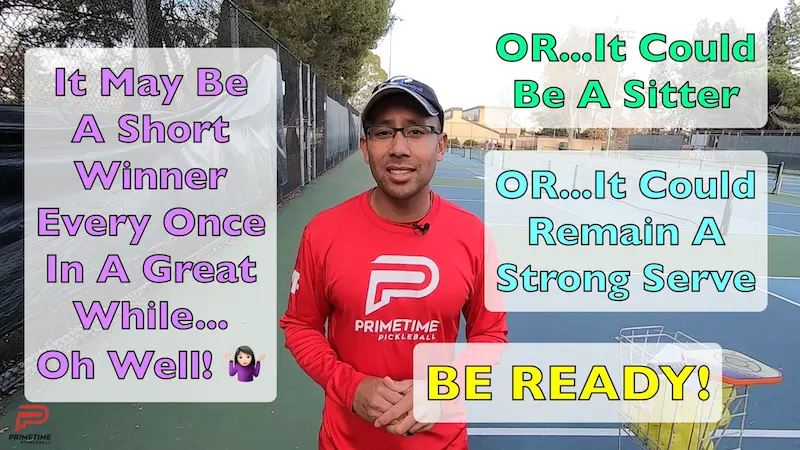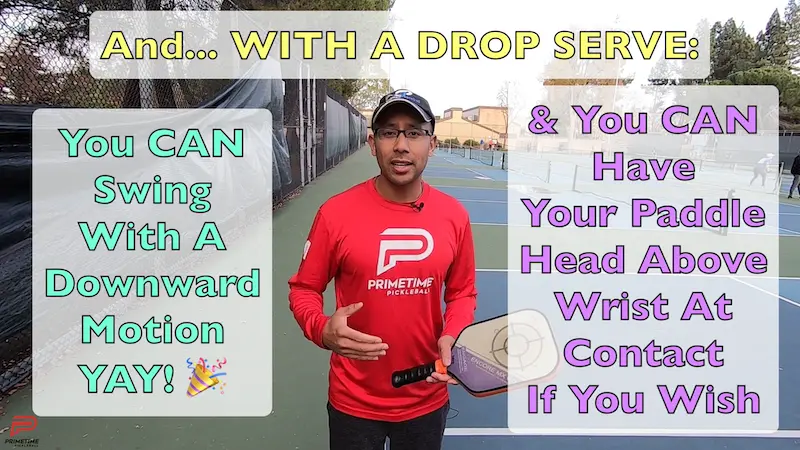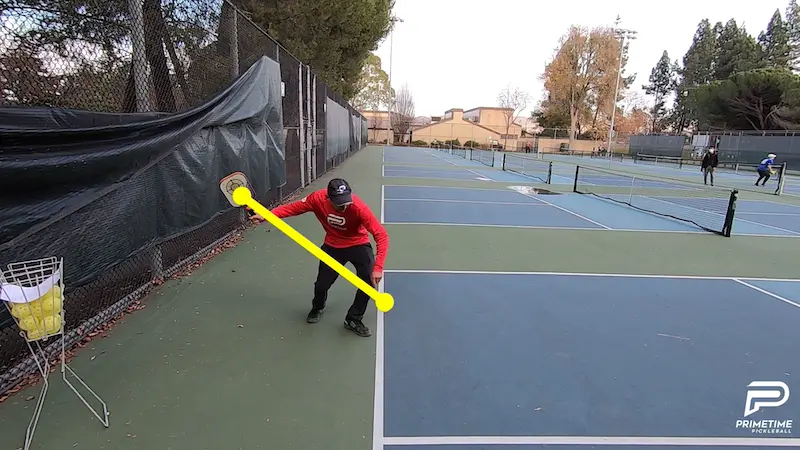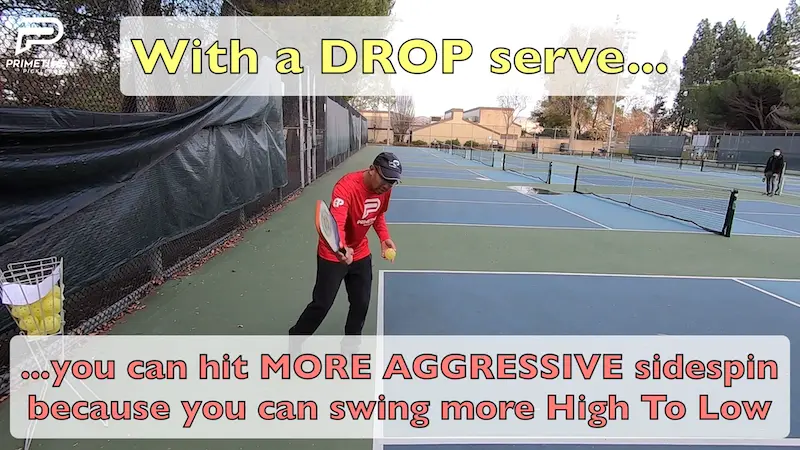In today’s blog we’re going to talk about a really hot topic right now and that involves two huge rule changes coming up in the rule book.
We’re not going to go much into detail of our personal opinions of these rule changes. That could be a long conversation.
What we’re going to do is we’re just going to give you some thoughts and also explain these two rules based on our knowledge of them.
Rule change number one has to do with service lets. You can forget about them. They no longer exist.
The new rule is that if you hit the serve and that ball hits the top of the net and lands in you have to play that out.
Previously, the rule was that if the ball hit the net on the serve and lands in bounds someone would just call that, either the returners or the referee, and you would play it over.
With this new rule, if you serve the ball and it clips the top of the net and lands in bounds you have to play that ball.
A couple thoughts on this.
For all those people out there that are like “oh this is just mind-blowing and I can’t believe this is happening”, the first thing to think about is that this doesn’t happen very often at all all over a series of games.
You may notice one or two of these over a series of games but it really doesn’t happen enough to affect the outcome of a match.
The second thing we want to say is if that ball hits the top of the net and lands in the court it still has to go beyond the non-volley zone line so if you have reasonable good mobility you should be able to still hit that return and come in and approach the net after that return.
We don’t think it’s that big of an issue. We actually think it hurts the server a little bit more than the returner.
Just think about this – as the game is progressing and people are working on more powerful serves with more topspin, usually those are the balls that clip the net and land in which means that a point that once was supposed to be replayed now has to just play on.
So, a good strong, deep serve, that clipped the top of the net that you would previously redo now becomes kind of like a sitter for the returning team. That’s one of the downsides for the server.
That’s the new rule now so remember – no more service lets. If it hits the net and lands in bounds, just play on.

So that was the first major rule change.
Before we move, on to the next one tell us what you think. Leave some comments on our YouTube post regarding this topic.
Do you think it’s a good thing?
Do you think it’s a bad thing?
What are your opinions? We’d love to hear them all.
Now let’s jump into rule change number two which is a big one and it really is an addition to the rules that we have today and that is the addition of the drop serve.
What is that?
We’re going to explain.
The traditional serve as we all know it is where you stand at the baseline and hold the ball out in front, you let the ball go and then hit it out of the air.
With this new rule, the drop serve, it actually allows people to hit the ball off the ground after it bounces.
One thing we do want to mention is that this is a provisional rule which means they’re just trying it out this year. It may or may not be around in the future.
We’re not going to go into if this is a good or bad thing for the game because that’s a long conversation. We’re just pointing out the new rule so that you are aware of it.
Now we want to go over the drop serve.
The the two criteria for the drop is you can’t bounce the ball with force and you can’t toss it up.
One thing you can do is you can drop it as high as you want. You can actually drop it from above your head.

You would think that this would be a major advantage but from what we’re seeing, even if you drop it from very high the ball really doesn’t bounce much higher. So, we don’t think it’s that much of an advantage anyways.
One of the things that people were saying is this does make it a lot easier for beginners to learn how to serve. A lot of times it can be hard to serve it out of the air so this new ruling will help players with no racket experience learn that service motion.
Beyond making it easier for beginners to learn how to serve, the drop serve adds some new and exciting serving options and opens up possibilities that were not previously available.
In particular, this is mostly due to now allowing for a downward motion meaning you can now swing from high to low with a drop serve.

More spins on the serve can now be achieved thanks to this change. Some players may also find it easier to hit the ball off a bounce rather than directly out of their hand.
We’re going to cover a few serves that we find really exciting and that you can now add to your arsenal of serves.
The slice forehand drop serve – The beauty of a slice is that you can get the ball to skip off the ground and stay relatively low. Getting your opponents to contact the ball low in pickleball is always good because they will have to hit the ball up and therefore they can be less offensive with it.
Hitting a hard and deep serve with a heavy slice is a great option as a server.
The super side spin forehand serve – You can definitely do this with a traditional serve. However, because with this shot you’re trying to cut and slice down in a high to low motion and you’re trying to contact this ball low, the drop serve actually helps you contact that ball really low. It will help get this ball bending as it bounces and after it bounces.

It’s realistically only achievable to get the ball to spin one way on the forehand for a righty from the perspective of the server. That ball will bend in the air from left to right and then bounce and head off more to the right.
If you want to get the ball bending in the other direction as a righty, meaning from right to left, you can do so but only with the backhand side.
For that reason you may want to experiment with a sidespin backhand serve.
However if you prefer your forehand side in general, as many do, then you will probably want to stick with the serve options available to you on the forehand which are traditional serve, both driving and topspin. And, you can now add in a slice and a side spin using the drop serve.
As a server you can do plenty of damage with just those four options.
Many players don’t prefer their backhand, but, if you do, then you can experiment hitting a backhand slice or a backhand drive, both flat, and one with topspin on your serve using a one-handed backhand.
You can even see how you feel about a two-handed backhand drive on the drop serve if you find that shot to be a strong one for you which you may particularly if you come from a tennis background.
All of these may be a bit easier to execute using a drop rather than a toss hit directly out of the hand. Many find that tossing and hitting directly out of the air from your hand on the backhand side is awkward and difficult.
The bounce gives you a bit more time to set up which may make it easier for many.
In any case, regardless of these new rules, it’s advisable to use drop feeding to work on your ground strokes.
Regardless of whether you plan to use the drop serve or not we highly recommend that you are able to drop feed yourself to hit all the shots we described in this blog that apply to you or that you could greatly benefit from adding to your game.
You will need them over the course of the point and a drop feed is a great way to train these shots.
Let us know what you think about these new rule changes by leaving comment on our YouTube video.